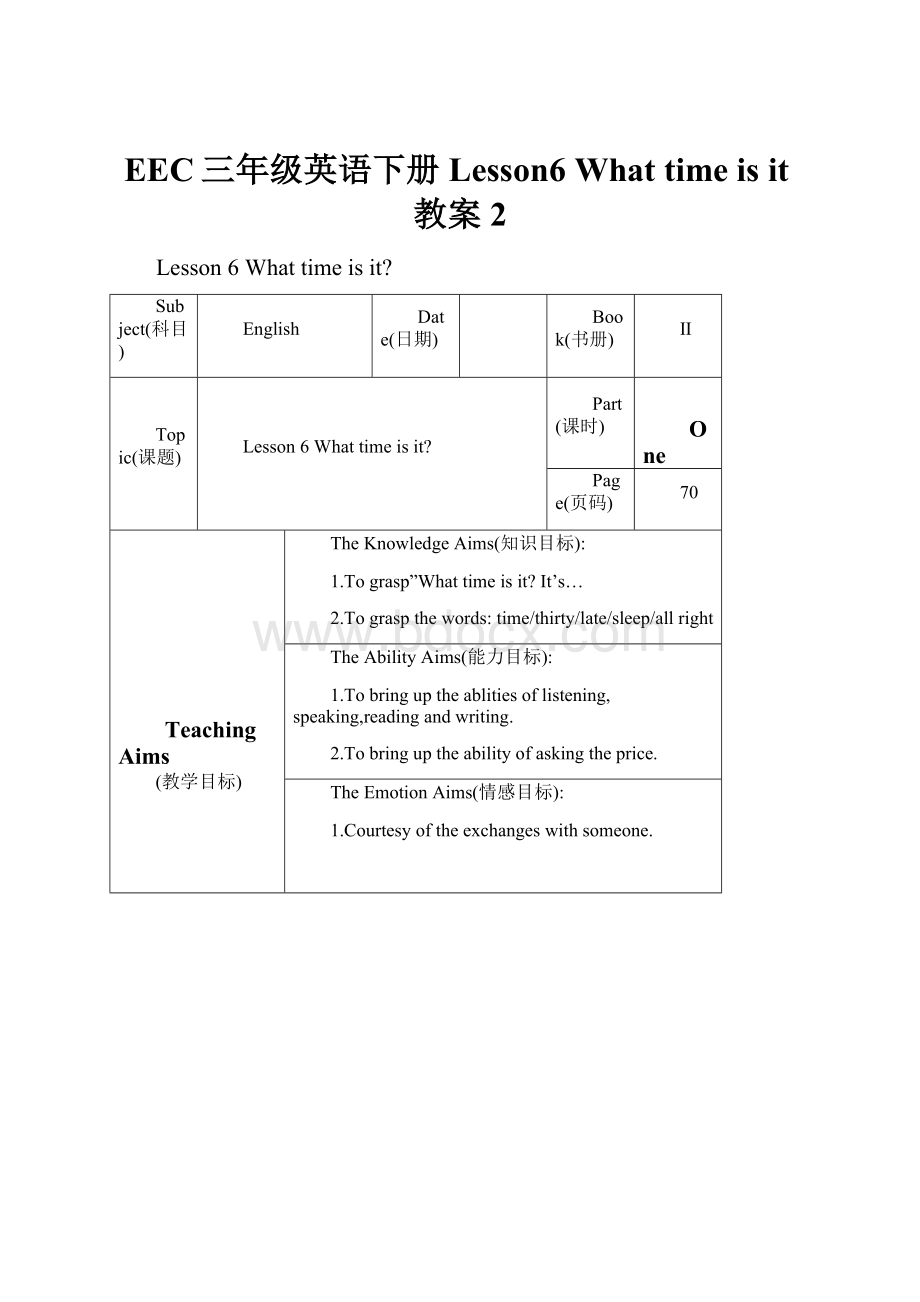EEC三年级英语下册 Lesson6 What time is it教案2.docx
《EEC三年级英语下册 Lesson6 What time is it教案2.docx》由会员分享,可在线阅读,更多相关《EEC三年级英语下册 Lesson6 What time is it教案2.docx(16页珍藏版)》请在冰豆网上搜索。

EEC三年级英语下册Lesson6Whattimeisit教案2
Lesson6Whattimeisit?
Subject(科目)
English
Date(日期)
Book(书册)
Ⅱ
Topic(课题)
Lesson6Whattimeisit?
Part(课时)
One
Page(页码)
70
TeachingAims
(教学目标)
TheKnowledgeAims(知识目标):
1.Tograsp”Whattimeisit?
It’s…
2.Tograspthewords:
time/thirty/late/sleep/allright
TheAbilityAims(能力目标):
1.Tobringuptheablitiesoflistening,speaking,readingandwriting.
2.Tobringuptheabilityofaskingtheprice.
TheEmotionAims(情感目标):
1.Courtesyoftheexchangeswithsomeone.
ImportantPoints
(教学重点)
It’s…
It’stimetosleep.
DifficultPoints
(教学难点)
Whattimeisit?
TeachingMethods
(教学方法)
Dialogeteachingmethod
Pictureteachingmethod
Instruments(教具)
recorder,numbercards
TeachingSteps(教学步骤)
Ⅰ.TheTeachingLeading(教学导入):
1.Greetings(打招呼):
T:
Hello.Boysandgirls.
T:
Canyousing“LittleTutuRabbit.”?
(T&Ssingtogether.)
2.Havearevision(复习):
Words:
much/many/want/skirt/shirt/coat/pants/socks/shoes…(spell)
3.TheLeadingWords(导语):
T:
whocantellmewhatisthis?
(pickoutaclockpicture)
S:
….
Ⅱ.TheTeachingPresentation(教学展开):
1.T:
OK.Now,openyourbookstopage70andlistentoit.
2.T:
Doyouseetheclock?
(S:
….)
Now,Iamtheclock.Whocantellmewhattimeisit?
(S:
…)
3.T:
Whattimeisit?
Towritethesentenceontheblackboard.
AskStoreaditonebyone.
4.Tostudytheword“time”
5.T:
Whattimeisit?
教师可以提示学生回答,说出时间的表达方法。
S:
It’s…
T:
Smart!
Canyoutellmewhattimedoyousleep?
6.Toteach”sleep”
T:
Doyouknowitsmeaning?
S:
…
T:
Good!
7.T:
Canyoutellmethetime?
AskStospeakthetime.
S:
It’s...
8.T:
Oh,youareallwrong.It’stenthirty.
Tostudytheword”thirty”.
9.Practicetospeakthetime.
S:
…
T:
You’reflying.
10.T:
Nowlet'spracticetosay“Whattimeisit?
”(Towrite.)
T:
Areyouclear?
11.Createasituation:
Dialogeplay.(Ex:
page70)
Content:
A:
Whattimeisit?
B:
It’stenthirty.
A:
It’slate.It’stimetosleep.
B:
Allright.
12.Topracticeitinpairs,thenplaythedialoge.
13.Toshow“Whattimeisit?
”
“It’stimetosleep.”
14.Listenandrepeat:
page70
(Turnonthereorder)
15.Dothewritingexercises:
(1)Towritethewords”time/thirty/late/sleep/allright”twotimes.
(2)Dotheexercisebook:
Ⅲ.TheSumUp(总结):
1.T:
Whathaveyoulearntfromthislesson?
(S:
….)
Homework:
(1)Toreadafterthetapeaboutpage70
(2)Theexercisebook:
TheBlackboardWriting(板书)
Lesson6WhatTimeIsIt?
WhatTimeIsIt?
Picture
clock
It’stenthirty.
It’stimetosleep.
ThinkingAfterClass(课后反思)
激发学生的学习兴趣,提高学生在课堂学习中处于交际的教学的第一着力点。
老师设计各种活动贯穿于整个课堂学生求知欲,表现于强,善于模仿乐于参加。
然学生获得成就感,开展小组竞赛活动或竞争性的游戏。
让他们有成就敢让学生学到真正的英语,让他们在语言实践活动中有用武之地。
TheTeachingPlan
Subject(科目)
English
Date(日期)
Book(书册)
Ⅱ
Topic(课题)
Lesson6WhatTimeIsIt?
Part(课时)
two
Page(页码)
71
TeachingAims
(教学目标)
TheKnowledgeAims(知识目标):
1.Tograsp”Pleaseturnoffthelight.”
2.Tograspthewords:
turn/off/night
TheAbilityAims(能力目标):
1.Tobringuptheablitiesoflistening,speaking,readingandwriting.
2.Tobringuptheabilityofbuyingsth..
TheEmotionAims(情感目标):
1.Howtoaskthetimeandhowtoanswerit.
ImportantPoints
(教学重点)
turnoff
DifficultPoints
(教学难点)
Differencebtweenturnoffandturnon.
TeachingMethods
(教学方法)
Dialogeteachingmethod
Pictureteachingmethod
Instruments(教具)
recorder
TeachingSteps(教学步骤)
Ⅰ.TheTeachingLeading(教学导入):
1.Greetings(打招呼):
T:
Hello.Boysandgirls.
T:
Canyouchant“Whatisthis”?
(T&Schanttogether.)
2.Havearevision(复习):
time/thirty/late/sleep…(spell)
T:
Whatisthis(that)?
3.TheLeadingWords(导语):
T:
Ithinkeveryone关灯beforegoingtosleep.DoyouknowhowtosayitinEnglish?
S:
….
Ⅱ.TheTeachingPresentation(教学展开):
1.T:
OK.Now,openyourbookstopage71andlistentoit.
2.Toexplans”Yes?
”
(教师解释英语口语化的表达)
T:
Pleaseturnoffthelight.”whatdoesitmean?
\
S:
…
4.Topracticethisphrase.
“Turnoffthelight”(教师注意”turn”的发音。
)
Towritethesentenceontheblackboard.
AskStoreaditonebyone.
5.T:
Doyouwanttoactit?
(Writeitontheblackboard.)
S:
Yes!
T:
Now,whocancomehereandactittotheclass?
S:
…
T:
Smart!
Andwhoknowshowtosay开灯inEnglish?
S:
..
T:
Verygood!
OK,readafterme”turnon”.Readitonebyone.
S:
..
6.Practicethesentences.
7.Createasituation:
First,listentopage71
Topracticeitinpairs,thenplaythedialoge.
8.Dothelisteningexercises:
page76“Listenandact”
9..Dothewritingexercises:
(1)Towritethewords”turn/off/night”twotimes.
(2)Dotheexercisebook:
Ⅲ.TheSumUp(总结):
1.T:
Whathaveyoulearntfromthislesson?
(S:
….)
Homework:
(1)Toreadafterthetapeaboutpage71
(2)Theexercisebook:
TheBlackboardWriting(板书)
Lesson6Whattimeisit?
turnon
turnoff
ThinkingAfterClass(课后反思)
教材为我们提供了很好的听、说、读、写训练内容,通过听听、说说、唱唱、做做,先培养语感,培养兴趣,然后进入开课以前,我就上节课所说内容,采用师师问答、生生问答、小组问答等多种形式进行复习,这一方法不仅有效的复习了上节课或以前所学的内容,而且为新授内容做了铺垫,起到了承上启下的作用。
字母教学。
让学生在快乐中学习英语,在知识中获得成功感。
TheTeachingPlan
Subject(科目)
English
Date(日期)
Book(书册)
Ⅱ
Topic(课题)
Lesson6Whattimeisit?
Part(课时)
three
Page(页码)
72-73
TeachingAims
(教学目标)
TheKnowledgeAims(知识目标):
1.Tograsp”CanIhavethesoap?
”
2.Tograspthewords:
soap/sure/water
TheAbilityAims(能力目标):
1.Tobringuptheablitiesoflistening,speaking,readingandwriting.
2.TobringuptheabilitytousetheEnglishknowledgeintheirlives..
TheEmotionAims(情感目标):
1.Courtesyofhowtoaskthetimeandanswerit.
ImportantPoints
(教学重点)
CanIhavethesoap?
DifficultPoints
(教学难点)
CanIhavethesoap?
Sure/Ofcourse.
TeachingMethods
(教学方法)
Dialogeteachingmethod
Pictureteachingmethod
Instruments(教具)
recorder
TeachingSteps(教学步骤)
Ⅰ.TheTeachingLeading(教学导入):
1.Greetings(打招呼):
T:
Hello.Boysandgirls.
T:
Let’schant“Whattimeisit?
”OK?
2.Havearevision(复习):
Words:
time/sleep/late/turnoff/turnon(spell)
3.TheLeadingWords(导语):
T:
Today,let’scontinuetolistenwhathappenedbtweenJackandTutu.
S:
….
Ⅱ.TheTeachingPresentation(教学展开):
1.T:
OK.Now,openyourbookstopage72-73andlistentothem.
2.Tsayswhocanturnonthelight?
(Write“turnon”ontheblackboard.)
S:
…
T:
welldone.Thankyou.
S:
Youarewelcome.
3.T:
whocanturnoffthelight?
(Someonecomestothefront.)
T:
Canyoudoit?
(指着一种水果。
)
S:
Yes,Ican.
T:
Didagoodjop.Now,whocantellme打开水龙头,howtosayitinEnglish?
S:
…
AskStoreaditonebyone.
4.Topractice“Turnonthewater.”
5.T:
Now,let’spracticethedialoge.
First,let’sstudyanewword.
Tostudy“soap”
T:
CanIhavethesoap?
S:
Yes,Ican./No,Ican’t.
6.Createasituation:
Inabathroom
(教师一块香皂摆放在桌子上。
)
Eg.A:
CanIhavethesoap?
B:
Sure.Hereyouare.
A:
Turnonthewater.
B:
Allright.
7.Practiceinpairs.
8.Role-play.
9..Listenandrepeat:
page72-73
(Turnonthereorder)
14.Dothewritingexercises:
(1)Towritethewords”soap/sure/water”twotimes.
(2)Dotheexercisebook:
Ⅲ.TheSumUp(总结):
1.T:
Whathaveyoulearntfromthislesson?
(S:
….)
Homework:
(1)Toreadafterthetapeaboutpage72-73
(2)Theexercisebook:
TheBlackboardWriting(板书)
Lesson6WhattimeIsIt?
CanIhavethesoap?
Yes,Ican./No,Ican’t.
ThinkingAfterClass(课后反思)
为了更好地实施新英语课程标准,我们必须采用多种多样的教学方式来组织教学工作。
对于我们小学阶段的英语教学来说,应该让学生在唱中学,在情景中说、在说中熟,在游戏中应用掌握。
在平时的教学中,教师要多用英语组织教学,开辟英语语言环境,再配以大量的感性材料和电化教学手段,多给学生提供英语对话、表演、朗读的机会和时间,使学生在语境中学好英语,始终保持浓在新授课中,我把单词、句子规范地写在黑板上的四线格中。
同时将认读训练贯穿在英语课堂教学中。
不再是单纯的听说游戏。
而是将游戏与听、说、认读教学相结合。
如游戏“小组比赛听音拍词”,教师将所学的单词写在黑板上,然后请两组学生开展接力赛。
TheTeachingPlan
Subject(科目)
English
Date(日期)
Book(书册)
Ⅱ
Topic(课题)
Lesson6Listeningandwritingexercises.
Part(课时)
four
Page(页码)
74-79
TeachingAims
(教学目标)
TheKnowledgeAims(知识目标):
Togooverthelearnedknowledge.
TheAbilityAims(能力目标):
1.Tobringuptheablitiesoflistening,speaking,readingandwriting.
2.Tobringuptheabilityofaskingthetime
TheEmotionAims(情感目标):
1.Courtesyofhowtoaskthetimeandanswerit.
ImportantPoints
(教学重点)
DifficultPoints
(教学难点)
TeachingMethods
(教学方法)
Instruments(教具)
recorder,
TeachingSteps(教学步骤)
Ⅰ.TheTeachingLeading(教学导入):
1.Greetings(打招呼):
T:
Hello.Boysandgirls.
2.Havearevision(复习):
Somewordsoflesson5
3.TheLeadingWords(导语):
T:
Todaywe’lldosomeexercisesaboutlesson6.
Ⅱ.TheTeachingPresentation(教学展开):
T:
Now,openyourbookstopage74andlistentoit.
Listeningexercises:
1.Lookandsay
AskStorepeatafterthetape.
(thirtythirty-onethirty-twofortyfiftysixty)
2.Sosmart!
A.Writethetime.
Asksb.toanswer.
B.Listenandact.
AskStolistenandact.
3.Review6Circlethecorrectpicture.
Listentothetapeandcircleit.
4.Funwithwords.
write.Whattimeisit?
AskSwritethembytheirselves.Tchectthaanswers.
5.Dothehandsontheclock.
Tguidthemtodo.
6.Chantthetext.
7.Dotheworkbook:
Ⅲ.TheSumUp(总结):
1.T:
Whathaveyoulearntfromthislesson?
(S:
….)
Homework:
(1)Torecitelesson6
(2)Theexercisebook:
TheBlackboardWriting(板书)
Lesson6WhattimeIsIt?
turnon
turnoff.
ThinkingAfterClass(课后反思)
改变原来机械的教学结构安排,根据学生年龄小,注意力集中时间短的特点,合理安排教学结构,使学生在老师“导演--指引”中学会在散发思维中学习,在娱乐演练中学习,在注意力有效集中中学习,使教学具有娱乐性,层次性,系统性,连贯性,实践性,开放性,创意性和艺术性,课堂教学由原来的学生不想说,不会说到现在的学生“思如泉涌”,满堂彩,教学的效果大大提高了。
实物、图片、简笔画、幻灯片等是英语教学中常用的直观教具,除教师制作直观教具外,我发动学生自己制作教具、学具。
如刚开始学字母时,就可让学生作字母卡片,以便进行同桌、分组、找朋友等多种形式的听说训练。
单词教学、对话教学等都可以让学生自己动手做图片卡、单词卡、句型卡或头饰、道具。
这样安排不仅有利于师生进行听说训练,而且也能促使学生动脑动手,激发学生的学习兴趣,提高课堂效率,教学效果非常好。
TheTeachingPlan
Subject(科目)
English
Date(日期)
Book(书册)
Ⅱ
Topic(课题)
Lesson6Writingexercises.
Part(课时)
five
Page(页码)
TeachingAims
(教学目标)
TheKnowledgeAims(知识目标):
Togooverthelearnedknowl